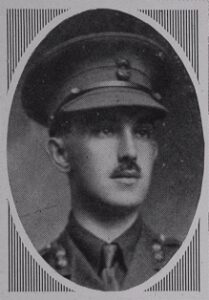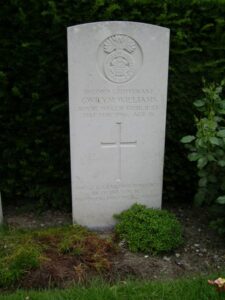Trelech is a village in the parish of Tre-lech a’r Betws, which sits some ten miles north-west of Carmarthen and six and a half miles south of Newcastle Emlyn, on the B4299 road. Just outside the village lies Penybont Baptist Chapel and within the grounds of its graveyard is a war memorial which commemorates three former members of the Chapel who fell during the Great War.
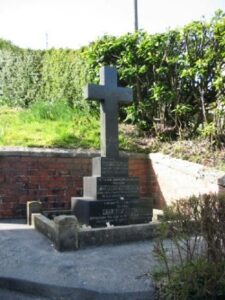
World War One, 1914-1918
David Davies, Private, 202484, Welsh Regiment. David was the son of John and Anna Davies, of Bryneglur, Mydrim. He was employed by D. Davies, at Llain, Penybont prior to enlisting at Carmarthen into the Welsh Regiment. David was posted to the 18th Battalion (2nd Glamorgan), Welsh Regiment, which was attached to 119 Brigade, 40th (Bantam) Division. The Division moved to France during the first week of June 1916, and moved to the front near Loos. Late in 1916 they moved south to the Somme, and fought at the Battle of the Ancre, and remained in the area over the winter. In March 1917 the Germans withdrew to their shortened line, called the Hindenburg Line, and the 40th Division were one of the Divisions that followed the withdrawal. Later in the year they took part in the Battle of Cambrai, playing an important role in the attack on Bourlon Wood. They remained in the area over the coming months, but were caught here by the German Spring Offensive of 21 March 1918, and fought there at the Battle of St Quentin and retreating back westwards fought at the First Battle of Bapaume. David was killed in action during the retreat, on 24 March 1918. He was 20 years old, and is commemorated on the Arras Memorial, France.
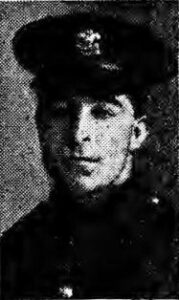
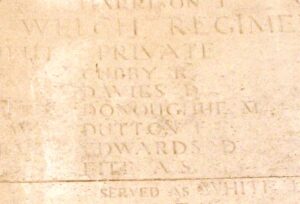
David Harries, Private, 200460, Welsh Regiment. David was the son of Benjamin and Esther Harries, and attended Penybont Chapel, Trelech. He married Jane Davies prior to enlisting at Carmarthen into the 1/4th Battalion, Welsh Regiment, which was the local Territorial Battalion, attached to 159 Brigade, 53rd (Welsh) Division. The Division landed at Cape Helles, Gallipoli, on 9 August 1915, and was immediately thrown into action, spending the next few days in isolated pockets, fighting against a Turkish counter-attack during the Battle of Sari Bair, and then at the Attack on Scimitar Hill. The Division remained here throughout the coming months, and suffered severe losses in manpower strength during the great November 1915 blizzard on Gallipoli, when its total strength was reduced to less than that of a full-strength Brigade. On 11 December 1915 the Division was evacuated to Mudros, and by 23 December 1915 were moved to Egypt. They remained on the Suez Canal Defences for the next twelve months. David was then attached to the 5th Company, Imperial Camel Corps, and took part in operations against the Sultan of Darfur. It was during such an operation that David was wounded, and he died on 15 January 1917. He was 22 years old, and is buried at Kantara War Memorial Cemetery, Egypt.
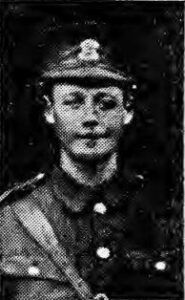
Gwilym Williams, Second Lieutenant, Royal Welsh Fusiliers. Gwilym was the son of William and Esther Williams, of Nantyrafr, Meidrim. He was educated at Aberystwyth University, and was well known as a prominent Welsh Bard prior to the war. Gwilym was commissioned at the outbreak of war into the 17th Battalion, Royal Welsh Fusiliers. The Battalion was raised at Llandudno on 2 February 1915 in 128 Brigade, 43rd Division. On 29 April 1915, the formation became 113 Brigade, 38th (Welsh) Division, and moved from North Wales to Morn Hill Camp, Winchester, where the 17th RWF moved to 115 Brigade, 38th Division. The Division arrived in France in December 1915, and was posted near Armentieres, where the men were familiarised with trench warfare over the coming months, while holding a relatively peaceful sector of the Western Front. In the middle of May 1916, the 17th RWF moved from comfortable billets at Robermetz to take up positions in the front line at Riez Bailleul. Gwilym was wounded by a German rifle grenade on 20 May, and was evacuated to the Military Hospital at Merville for treatment. He died of his wounds on 21 May 1916. He was 26 years old, and was buried with full military honours at Merville Communal Cemetery the following day.
